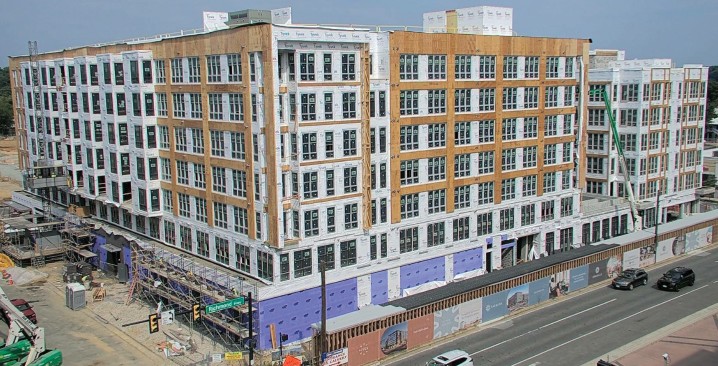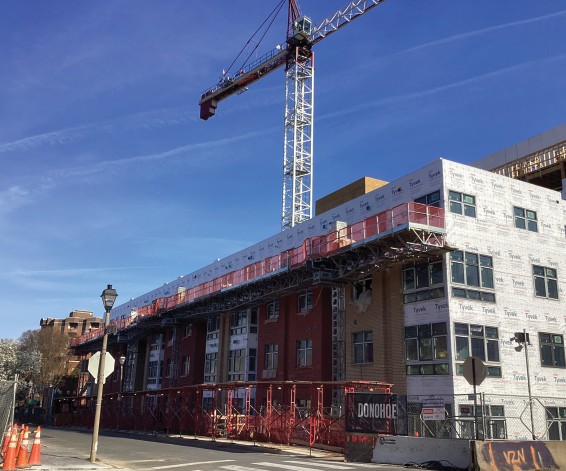From Framing Downtown to Dirt Lots
Insights from Zero-Lot Lines to Wide-Open Builds
by Framing Today Staff
Framing buildings in wide-open suburban fields might be the norm for many framers, but for Pedro Loureiro, President of Nomad Framing and current President of the National Framers Council (NFC), and Chris Breedlove, President of Ace Carpentry, Inc. and NFC Steering Committee member, the real test of skill, strategy, and coordination plays out in the heart of the city. Their experience lies in downtown urban framing projects, often set on zero-lot lines, with limited room for staging, tight delivery windows, and carefully timed coordination with every trade involved. These conditions present a completely different playbook than a typical "cornfield" job, as they say.

Pedro and Chris approach the urban challenge from two distinct angles. Pedro's team focuses on using telescopic handlers and rotating lifts like Magni equipment, while Chris's team frequently integrates tower cranes and mobile cranes into its strategy. Both methods are effective, and both reflect how site constraints, cost structures, and team workflows shape framing strategy.
Cranes or No Cranes?
Two Proven Approaches
To use cranes or not to use cranes – that is the question. There is no right or wrong answer; it depends upon your needs, space, project, budget, and a host of other factors. Pedro’s company relies almost entirely on Magni equipment to move materials. Even in dense urban zones, Pedro finds ways to hoist and stage materials without needing a crane. A Magni can be operated by certified in-house team members and does not require specialized union operators, which adds flexibility for scheduling and task flow.
Chris, on the other hand, makes cranes a central part of his process. His team often works on sites where tower cranes are already installed to support the concrete superstructure, and his approach includes working closely with general contractors to align usage schedules.
Both agree that the most important point is that framers understand their options. Whether relying on rotating lifts or tower cranes, the decision should be based on the specific constraints and goals of each site.
Bundling Trusses: Offsite Prep, Onsite Advantage
Chris points to unit-specific truss bundling as a key tactic in managing dense downtown jobs. "You don’t have room to shake out and organize trusses onsite," he explains. "So we work with our component manufacturer (CM) to have them bundled by unit offsite. That way, they can be picked straight off the truck and installed immediately."
This approach requires clear communication with component manufacturers, who bundle and label deliveries in the sequence in which the crews will install them. "We order by unit number and stage our deliveries accordingly, specifying which units we can take on a given day,” says Chris. This strategy keeps them efficient and helps to minimize time lost to sorting and staging.

Pedro takes a similar view. While his team may not use cranes, it also relies on just-in-time delivery and carefully organized shipments. His crews typically plan out the next twelve hours of work and schedule deliveries in narrow windows, often working around local traffic patterns, schools, and permitted delivery hours. "It’s literally just-in-time delivery. It becomes a very coordinated effort,” says Pedro. This intense coordination allows the team to move quickly and stay productive with minimal space.
Lessons from Tight Sites
Urban framing projects are shaped by their surroundings. From narrow access points to pedestrian-heavy sidewalks and tight delivery windows, these jobs require a unique mindset. Chris’s team regularly reviews the GC's Site Utilization Plan (SUP) to understand delivery routes, crane positioning, staging zones, and even local noise ordinances.
Pedro emphasizes the importance of on-the-ground recon, saying,. "We’ll figure out the route through the major highway, and we’ll actually drive it to make sure there isn’t something we can’t pick up on Google Maps, whether it’s an overpass, tight turns, or narrow streets. That way we can update our trucking partners, for trusses or lumber, to make sure we know exactly how to get there.” Knowing in advance whether there are low bridges or one-way streets saves valuable time and prevents delivery disruptions.
Both Pedro and Chris highlight how careful logistics planning keeps material moving and the job on schedule. Whether it's coordinating flaggers for deliveries, working with local departments for road access, or laying out materials under podium levels, framing in the city is all about staying a step ahead.
Translating Urban Framing to Larger Jobsites
Although much of their expertise comes from zero-lot-line projects, Pedro and Chris are quick to point out that many of the same lessons apply on more spacious sites. "We used to send a foreman to a cornfield job and just let it roll," Pedro says. "Now, we bring the same structured planning we use in urban projects. It helps with everything from waste reduction to crew efficiency."
Chris adds that tactics like bundling, lean delivery schedules, and early coordination with other trades translate well to larger jobs, saying, "The margin for error might feel wider on a bigger site, but staying disciplined with your planning always pays off."
In fact, both believe that urban framing sharpens a builder's process. Urban jobs teach one to be deliberate, and that mindset improves every kind of project.
Urban framing projects are shaped by their surroundings. From narrow access points to pedestrian-heavy sidewalks and tight delivery windows, these jobs require a unique mindset.
Tips and Takeaways
Whether working downtown or in an open field, Pedro and Chris have a few consistent recommendations:
- Start with a clear logistics plan: Identify delivery slots, staging areas, and flow of work early on.
- Do site visits whenever possible: There's no substitute for seeing the site, or the route to the site, firsthand.
- Know your tools and constraints: Whether it's a crane or a Magni, match your equipment to the site and job.
- Watch for site-specific utility challenges: Overhead power lines or underground vaults can restrict equipment movement. These need to be identified and worked around during preconstruction planning. This is true for any jobsite.
- Coordinate with the GC and all trades: Communication is key to avoiding scheduling conflicts and being as efficient as possible.
- Keep safety visible and proactive: Especially in high-traffic environments, protecting both crews and the public is essential.
- Plan deliveries with precision: Consider local haul routes, traffic patterns, and staging capacity.
Above all, both professionals emphasize that there's no one-size-fits-all answer. The tools might differ, but the goal is the same. "We want to keep moving, keep building, and keep everyone safe,” Pedro concludes.
Urban framing doesn’t just demand agility; it rewards preparation, creativity, and teamwork. Whether the project involves lifting with a crane or staging with a Magni, Pedro and Chris show that successful framing is less about space and more about strategy.
